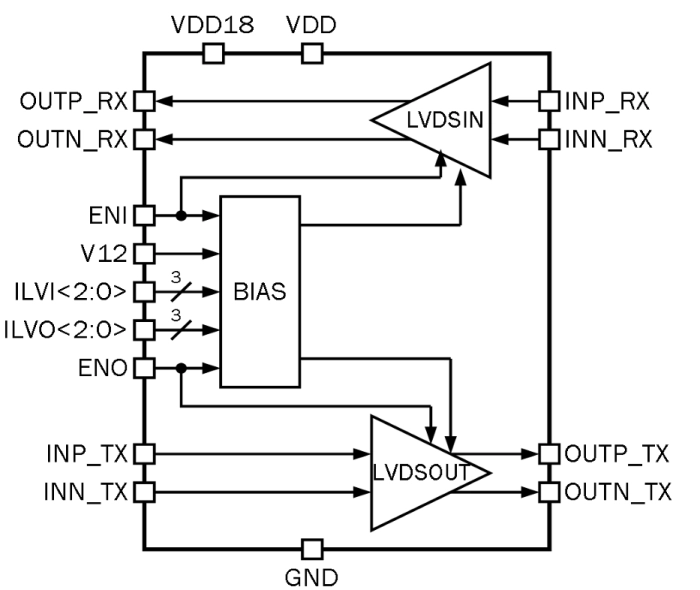090TSMC_LVDS_02 consists of transmitter (LVDSOUT), receiver (LVDSIN) and a bias. The LVDS transmitter consists of a current source (nominal 3.5mA) that drives the differential pair lines and common-mode regulator, which provides the output common-mode voltage signal equal 1.25V. The output current adjustment is defined by the digital code register ILVO<2:0>. The receiver has high DC input impedance, so the majority of driver current flows across the 100Ohm external termination resistor generating about 350mV across the receiver inputs. When the driver switches, it changes the direction of current flow across the resistor, thereby creating a valid logic state of “1” or “0”. That is, it transforms 35mV input signal to CMOS 1.8V output signal. The internal current setting is defined by digital code register ILVI<2:0>.
1.6 Gbps DDR Programmable LVDS Transmitter/Receiver
Overview
Key Features
- TSMC 90 nm CMOS
- 1 V CMOS input logic signal
- Output current digital 3-bit adjustment (from 0.75 mA to 6.5 mA)
- 1.6 Gbps (DDR MODE) switching rates for transmitter
- Low power dissipation (1.4 mW) for receiver
- Low power dissipation (16.56 mW) for transmitter
- Conforms to TIA/EIA-644 LVDS standards
- Military temperature range: from -60 °C to + 125 °C
- Propagation delay 590 ps for transmitter
- Propagation delay 500 ps for receiver
- Internal current digital 3 bit adjustment (high inner current for high frequency, from 40 to 300 uA) for receiver
- Portable to other technologies (upon request)
Block Diagram

Applications
- Point-to-point data transmission
- Multidrop buses
- Clock distribution
- Backplane receiver
- Backplane data transmission
- Cable data transmission
Deliverables
- Schematic or NetList
- Abstract model (.lef and .lib files)
- Layout view (optional)
- Behavioral model (Verilog)
- Extracted view (optional)
- GDSII
- DRC, LVS, antenna report
- Test bench with saved configurations (optional)
- Documentation
Technical Specifications
Short description
1.6 Gbps DDR Programmable LVDS Transmitter/Receiver
Vendor
Vendor Name
Foundry, Node
TSMC 90 nm CMOS Logic Process
Maturity
Silicon proven
Availability
Now
TSMC
Silicon Proven:
90nm
zzz